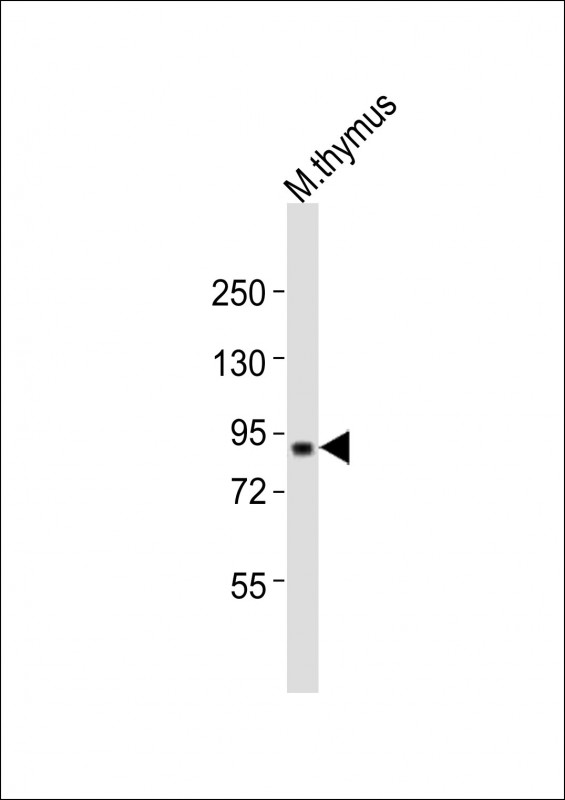Mouse Cxxc1 Antibody (Center)
Purified Rabbit Polyclonal Antibody (Pab)
- SPECIFICATION
- CITATIONS
- PROTOCOLS
- BACKGROUND

Application
| WB, E |
|---|---|
| Primary Accession | Q9CWW7 |
| Reactivity | Mouse |
| Host | Rabbit |
| Clonality | polyclonal |
| Isotype | Rabbit IgG |
| Calculated MW | 76167 Da |
| Gene ID | 74322 |
|---|---|
| Other Names | CXXC-type zinc finger protein 1, CpG-binding protein, PHD finger and CXXC domain-containing protein 1, Cxxc1, Cgbp, Pccx1 |
| Target/Specificity | This Mouse Cxxc1 antibody is generated from a rabbit immunized with a KLH conjugated synthetic peptide between 364-399 amino acids from the Central region of Mouse Cxxc1. |
| Dilution | WB~~1:2000 E~~Use at an assay dependent concentration. |
| Format | Purified polyclonal antibody supplied in PBS with 0.09% (W/V) sodium azide. This antibody is purified through a protein A column, followed by peptide affinity purification. |
| Storage | Maintain refrigerated at 2-8°C for up to 2 weeks. For long term storage store at -20°C in small aliquots to prevent freeze-thaw cycles. |
| Precautions | Mouse Cxxc1 Antibody (Center) is for research use only and not for use in diagnostic or therapeutic procedures. |
| Name | Cxxc1 |
|---|---|
| Synonyms | Cgbp, Pccx1 |
| Function | Transcriptional activator that exhibits a unique DNA binding specificity for CpG unmethylated motifs with a preference for CpGG. |
| Cellular Location | Nucleus speckle {ECO:0000250|UniProtKB:Q9P0U4}. Nucleus. Note=Associated with euchromatin. During mitosis, excluded from condensed chromosomes (By similarity). {ECO:0000250|UniProtKB:Q9P0U4} |
| Tissue Location | Expressed in seminiferous tubules and in both germ cells and Sertoli cells. Highly expressed in spermatogonia, weakly expressed in leptonema and zygonema, and then again high expression in pachynema and diplonema, decreasing to undetectable levels in spermatids. |

Thousands of laboratories across the world have published research that depended on the performance of antibodies from Abcepta to advance their research. Check out links to articles that cite our products in major peer-reviewed journals, organized by research category.
info@abcepta.com, and receive a free "I Love Antibodies" mug.
Provided below are standard protocols that you may find useful for product applications.
Background
Transcriptional activator that exhibits a unique DNA binding specificity for CpG unmethylated motifs with a preference for CpGG.
References
Carninci P.,et al.Science 309:1559-1563(2005).
If you have used an Abcepta product and would like to share how it has performed, please click on the "Submit Review" button and provide the requested information. Our staff will examine and post your review and contact you if needed.
If you have any additional inquiries please email technical services at tech@abcepta.com.













 Foundational characteristics of cancer include proliferation, angiogenesis, migration, evasion of apoptosis, and cellular immortality. Find key markers for these cellular processes and antibodies to detect them.
Foundational characteristics of cancer include proliferation, angiogenesis, migration, evasion of apoptosis, and cellular immortality. Find key markers for these cellular processes and antibodies to detect them. The SUMOplot™ Analysis Program predicts and scores sumoylation sites in your protein. SUMOylation is a post-translational modification involved in various cellular processes, such as nuclear-cytosolic transport, transcriptional regulation, apoptosis, protein stability, response to stress, and progression through the cell cycle.
The SUMOplot™ Analysis Program predicts and scores sumoylation sites in your protein. SUMOylation is a post-translational modification involved in various cellular processes, such as nuclear-cytosolic transport, transcriptional regulation, apoptosis, protein stability, response to stress, and progression through the cell cycle. The Autophagy Receptor Motif Plotter predicts and scores autophagy receptor binding sites in your protein. Identifying proteins connected to this pathway is critical to understanding the role of autophagy in physiological as well as pathological processes such as development, differentiation, neurodegenerative diseases, stress, infection, and cancer.
The Autophagy Receptor Motif Plotter predicts and scores autophagy receptor binding sites in your protein. Identifying proteins connected to this pathway is critical to understanding the role of autophagy in physiological as well as pathological processes such as development, differentiation, neurodegenerative diseases, stress, infection, and cancer.


